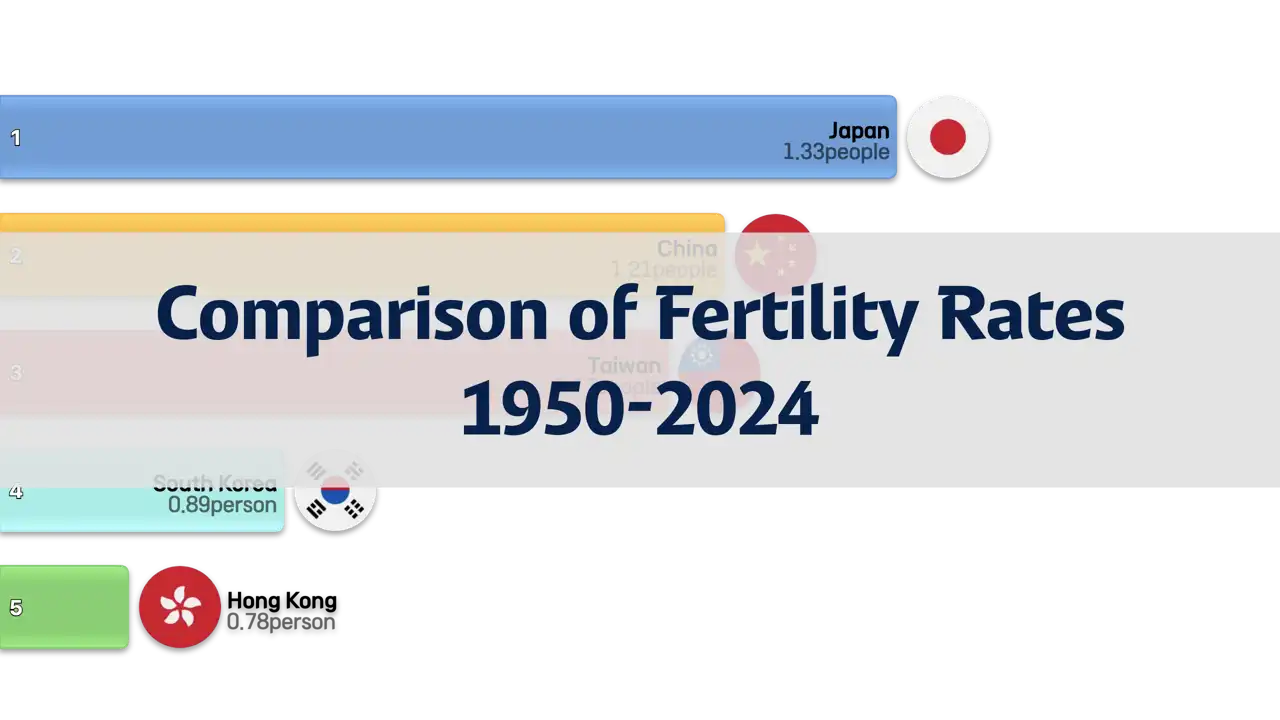
2023 Fertility Rate Rankings: Japan vs China vs Korea vs Taiwan vs Hong Kong—Who Tops the List?
- ASUMUP
- Society
- August 16, 2024
The fertility rate is a critical metric that reflects the average number of children born to a woman over her lifetime. It is a significant indicator of a country's demographic trends and future population growth. In 2023, several East Asian regions—Japan, China, South Korea, Taiwan, and Hong Kong—have shown strikingly low fertility rates, which are a cause for concern among policymakers and society at large.
This blog post delves into the fertility rate statistics of these regions, ranking them from the highest to the lowest. We’ll explore the socio-economic and cultural factors contributing to these numbers and what they mean for the future of these nations. Whether you're interested in demographics, economics, or social trends, understanding these fertility rates offers valuable insights into the challenges these regions face.
Join us as we break down the data and discuss the implications of these rankings in the context of an aging population, labor force challenges, and the broader impact on global demographics.
2023 East Asia Fertility Rate Showdown!
- 1st Japan - 1.3148
- 2nd China - 1.1899
- 3rd Taiwan - 1.1504
- 4th Republic of Korea - 0.8831
- 5th China, Hong Kong Special Administrative Region - 0.7709
5th China, Hong Kong Special Administrative Region - 0.7709
Hong Kong has the lowest fertility rate among the regions compared, with a rate of 0.7709 in 2023. This exceptionally low figure is indicative of the significant socio-economic challenges faced by residents, including extremely high property prices, competitive job markets, and the demands of a fast-paced urban lifestyle. In Hong Kong, the cost of living is one of the highest in the world, making it difficult for many to afford having children.
Cultural factors also play a role, as many Hong Kongers prioritize career advancement and financial security over starting families. The government's efforts to encourage higher birth rates through subsidies and family support programs have had limited success, as the high cost of living and societal expectations continue to pose significant barriers to increasing the fertility rate.
4th Republic of Korea - 0.8831
South Korea’s fertility rate is the lowest among the major East Asian economies, standing at 0.8831 in 2023. This alarmingly low figure reflects deep-seated issues in South Korean society, including intense academic and professional pressures, high living costs, and housing challenges. The culture of long working hours and the high cost of private education further discourage many from having more than one child, if any at all.
Despite government efforts to boost the birth rate through financial incentives, improved maternity and paternity leave, and campaigns promoting work-life balance, these measures have yet to produce significant results. The rapidly aging population and low fertility rate are creating concerns about the future workforce and economic sustainability, making this a critical issue for South Korea.
3rd Taiwan - 1.1504
Taiwan ranks third in this comparison with a fertility rate of 1.1504 in 2023. Similar to other East Asian regions, Taiwan faces the challenge of a declining birth rate, which is well below the replacement level. The causes are multifaceted, including economic pressures, late marriages, and the high cost of raising children. In Taiwan, there is also a strong cultural expectation for women to balance career and family, which often leads to the postponement of childbirth or decisions to have fewer children.
The Taiwanese government has been proactive in addressing these concerns, offering various incentives and support programs for families. However, these efforts have not yet led to a significant increase in the fertility rate. The low birth rate poses a risk to Taiwan’s future economic stability, as a shrinking population could lead to a reduced workforce and increased burden on social services for the elderly.
2nd China - 1.1899
China’s fertility rate in 2023 is 1.1899, placing it second among the regions compared. This figure is also below the replacement level, highlighting China’s ongoing demographic challenges. The one-child policy, which was in effect from 1979 to 2015, has had long-lasting effects on the country’s population structure, contributing to a rapidly aging population and a shrinking workforce. Although the policy has been relaxed to allow for two or even three children, many couples are hesitant to have more due to the high cost of education, housing, and healthcare.
China's economic transformation and urbanization have also played a role in lowering the fertility rate. As more people move to cities and pursue careers, the traditional family structure is changing, and fewer people are choosing to have large families. The government has recognized the urgency of the situation and is implementing measures to encourage births, but changing cultural norms and economic realities are proving to be significant barriers.
1st Japan - 1.3148
Japan tops the 2023 fertility rate rankings among East Asian regions with a rate of 1.3148. Despite being the highest in this comparison, Japan’s fertility rate is still below the replacement level of 2.1, necessary to maintain a stable population without immigration. This low fertility rate is the result of several factors, including economic uncertainty, the high cost of living, and a culture that places significant demands on parents, particularly mothers. The aging population and shrinking workforce are pressing issues that Japan faces due to these trends.
The Japanese government has introduced various policies to encourage higher birth rates, such as financial incentives for families, improved childcare facilities, and support for work-life balance. However, the results have been modest, as societal expectations and the economic environment continue to deter many from having larger families. Japan’s situation highlights the complex interplay of tradition, modernity, and economic factors in shaping demographic trends.
Other Posts in the Society
Categories
- National Rankings(43)
- Science & Technology(1)
- Sports(24)
- Economy(30)
- Society(12)
- Culture(7)
Recent Posts
![Bayern Spent HOW MUCH on Harry Kane?! Ranking Their Top 10 Biggest Signings Ever]() A deep dive into Bayern Munich's ten most expensive transfers, exploring how the club's spending strategy has evolved to chase European glory.
A deep dive into Bayern Munich's ten most expensive transfers, exploring how the club's spending strategy has evolved to chase European glory.![Arsenal's Record-Shattering Spree: From a €116M Gamble to a Flop, Who Was Worth the Cash?]() A deep dive into Arsenal's top 10 most expensive signings, analyzing the successes, the failures, and the massive fees that have defined the club's modern transfer strategy.
A deep dive into Arsenal's top 10 most expensive signings, analyzing the successes, the failures, and the massive fees that have defined the club's modern transfer strategy.![Chelsea Cashes In BIG TIME! Who Really Won the 25/26 Summer Transfer Window Money Game?]() A deep dive into the top 10 clubs that made the most money from player sales during the wild 25/26 summer transfer window.
A deep dive into the top 10 clubs that made the most money from player sales during the wild 25/26 summer transfer window.![Liverpool's Record-Breaking €483M Spree! Did They Just Buy the Premier League Title?]() A deep dive into the 25/26 summer transfer window reveals Liverpool's record-breaking spending spree as Premier League clubs continue to dominate the market.
A deep dive into the 25/26 summer transfer window reveals Liverpool's record-breaking spending spree as Premier League clubs continue to dominate the market.![You Won't Believe How Much a Loaf of Bread Costs in These Countries! (Spoiler: It's INSANE)]() This post explores the top 10 countries with the most expensive bread, revealing how factors like import reliance and tourism dramatically inflate the cost of this basic staple.
This post explores the top 10 countries with the most expensive bread, revealing how factors like import reliance and tourism dramatically inflate the cost of this basic staple.











